Sometimes, finding real prosciutto isn’t that easy, especially if you’re outside of Europe or away from specialty grocers.
Whether you’re building a charcuterie board, wrapping asparagus, or making a dish that calls for paper-thin slices of cured pork, knowing which meats can stand in for prosciutto is essential.
As someone who’s been curing, slicing, and savoring dry-cured meats for over two decades, I’ve tasted and made just about every type of substitute listed here. I’ll walk you through the best options that actually make sense as alternatives, not just from a flavor perspective, but also in terms of how they’re made and served.
Let’s start with the best prosciutto substitutes you can use, especially when the real thing is hard to find or just out of your price range.
Good Substitutes for Prosciutto
These alternatives are all dry-cured meats, typically sliced wafer-thin and served as part of a charcuterie board, antipasto platter, or even cooked into recipes.
From Italian classics to Spanish specialties, I’ve listed the options that most closely match prosciutto in terms of texture, flavor, and preparation style.
- Serrano Ham
- Capicola / Coppa
- Pancetta
- Culatello
- Black Forest Ham
- Iberian Jamon
- Guanciale
- Speck
Each of these cured meats brings something slightly different to the table—some offer a smokier edge, others are fattier or more fragrant. I’ll break down each in detail in the sections below, starting with one of my favorites from Spain.
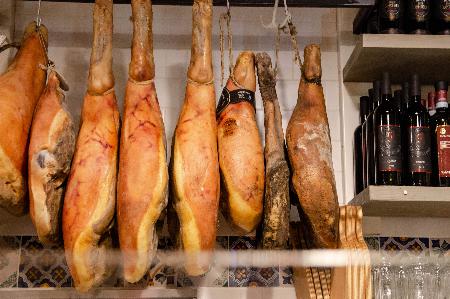
Serrano Ham
Serrano ham is a great substitute for prosciutto. It’s a dry-cured Spanish ham made from the hind leg of pigs, traditionally cured in mountain air and dried for 12–18 months. While similar in appearance and texture, it has a slightly firmer bite and a deeper, nuttier profile due to the breed and aging conditions.
In my experience, it slices just as thin as prosciutto and works perfectly for wrapping fruit, layering in sandwiches, or plating with cheese. It tends to be a little less fatty.
If you’re looking for a reliable prosciutto alternative that’s widely available and still made using time-honored dry-curing methods, Serrano ham is probably your best bet.
Next up—one of the most flavorful shoulder cuts in Italian charcuterie that rivals prosciutto for complexity.
Capicola / Coppa
Capicola (also called Coppa or Capocollo, depending on the region of Italy) is another excellent prosciutto alternative. It’s made from the upper shoulder or neck of the pig and cured whole in a natural casing for at least six months. This cut has just the right mix of fat and lean muscle, giving it a rich flavor that rivals the best hams.
Unlike prosciutto, which is made from the leg, capicola has a rounder cross-section and more marbling throughout. This results in a buttery texture and bold flavor—especially when spices like black pepper, fennel, or paprika are added, depending on regional traditions.
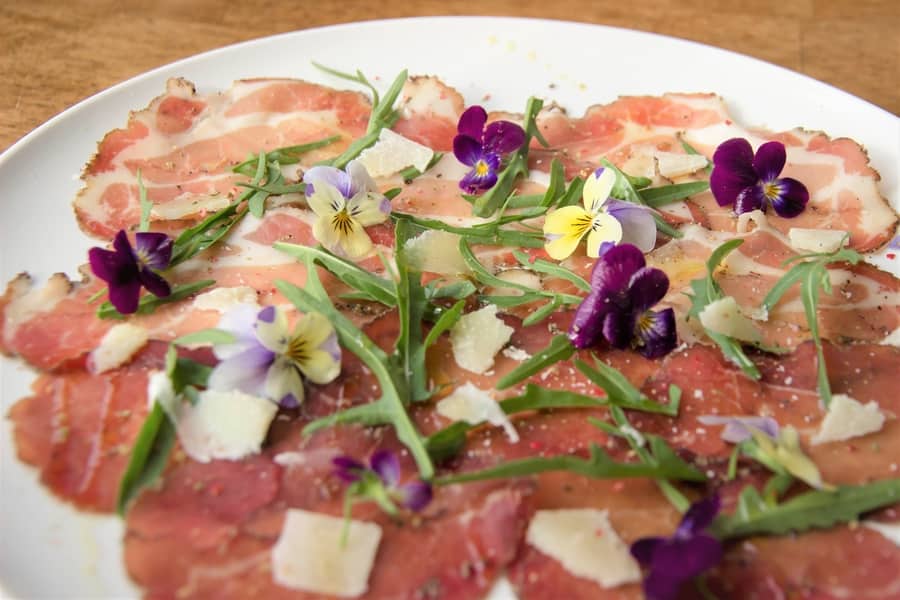
When sliced paper thin—just like prosciutto—capicola melts in the mouth with a spicy, slightly sweet finish. It’s one of the most accessible and versatile dry-cured meats you can find, often sliced to order at the deli counter.
If you’re building a classic antipasto platter cured meats selection, capicola is one of my go-tos alongside prosciutto or as a stand-in when it’s unavailable.
Just be sure to request those ultra-thin slices—or better yet, use a proper slicer at home if you want to match the delicate salt balance that cured meats are designed around. If you’re curious how I do this, here’s a breakdown of how to slice cured meat paper thin with precision.
Capicola is technically part of the broader Italian category of salumi, and the process is very similar to prosciutto. It’s dry-cured over months, often aged in cellars, and loses about 35–40% of its weight during drying. This intensifies the flavor and ensures preservation—just like in the dry-cured meat guide I put together.
For a deep dive into how Capocollo is made and the strict regional controls around its labeling, you can also check the Capocollo product description from Salumi Consortium.
Out of all the prosciutto substitutes, capicola is one of the closest in terms of tradition, effort, and flavor payoff—especially when made the old way. Just don’t confuse it with the mass-produced deli meats labeled similarly but cooked or injected. The dry-cured version is the real deal.
Next up: the salty, fatty, rolled-up beauty that is pancetta—another pork classic that can sometimes be used in place of prosciutto, depending on how it’s prepared.
Pancetta
Pancetta is another excellent substitute for prosciutto, though it comes from a different part of the pig—the belly. It’s cured with salt and spices, often rolled into a log and dried for weeks or months, depending on the regional style. When thinly sliced, pancetta brings a fatty, savory richness that complements many of the same dishes as prosciutto.
There are two common types of pancetta: arrotolata (rolled) and stesa (flat). The rolled version is what you’ll typically see thin-sliced at the deli counter or vacuum-sealed in specialty stores. The flat version is often cubed for cooking—especially in Italian dishes like carbonara or amatriciana. Just make sure you’re using the dry-cured version, not the fresh, unsmoked kind meant solely for cooking.
Because it’s from the belly, pancetta tends to be fattier than prosciutto. But that fat is part of the appeal—when sliced wafer-thin, it nearly melts on your tongue. I’ve made my own pancetta using dry bay leaf powder, pepper, and a slow dry cure process over 6 weeks. That melt-in-the-mouth texture is what elevates pancetta from just another pork product to a real prosciutto stand-in.
One thing to keep in mind: pancetta doesn’t go through the same extensive drying time as prosciutto (which can take over a year), so the flavor isn’t quite as deep or nutty. But when you’re after that fatty, salty hit with a delicate spice finish, it’s a solid alternative.
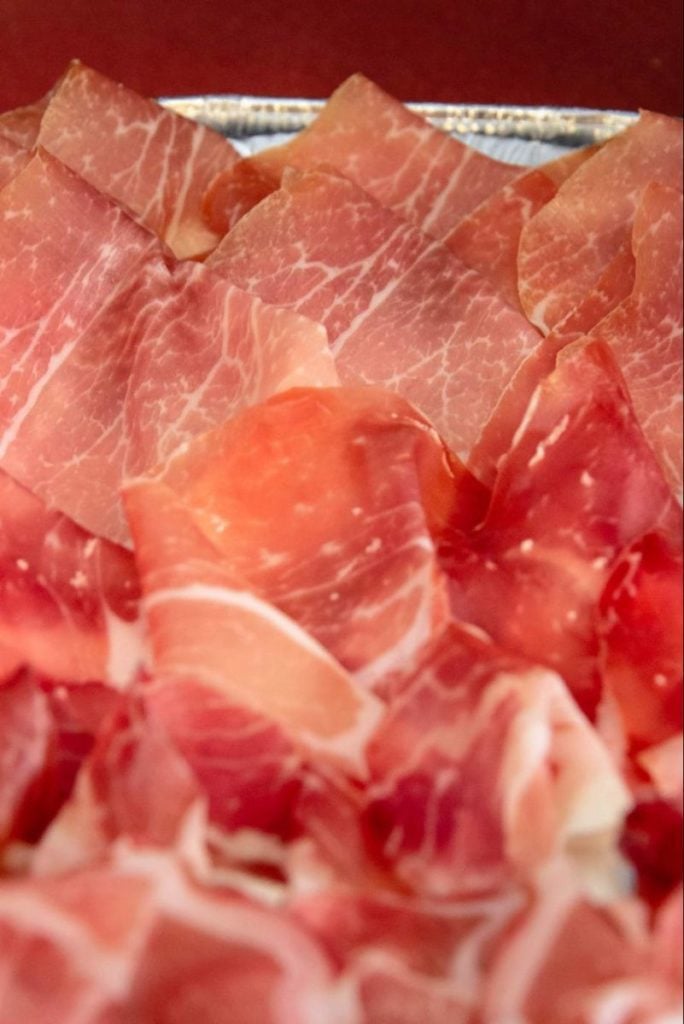
For those diving deeper into traditional Italian cured meats, pancetta is one of many dry-cured styles you’ll find among salumi. If you’re curious about how pancetta fits into the wider Italian charcuterie tradition, here’s a full breakdown of Italian salumi explained.
In cooking, pancetta has an edge over prosciutto because of its higher fat content and intense aroma when rendered. But if you’re serving it as part of a cured meat plate, slice it paper-thin and let it come to room temperature. That’s when the fat softens and the flavor really opens up—similar to high-quality prosciutto.
Next, we’ll head back to the Parma region and explore one of the most refined and rare prosciutto-style hams out there—culatello.
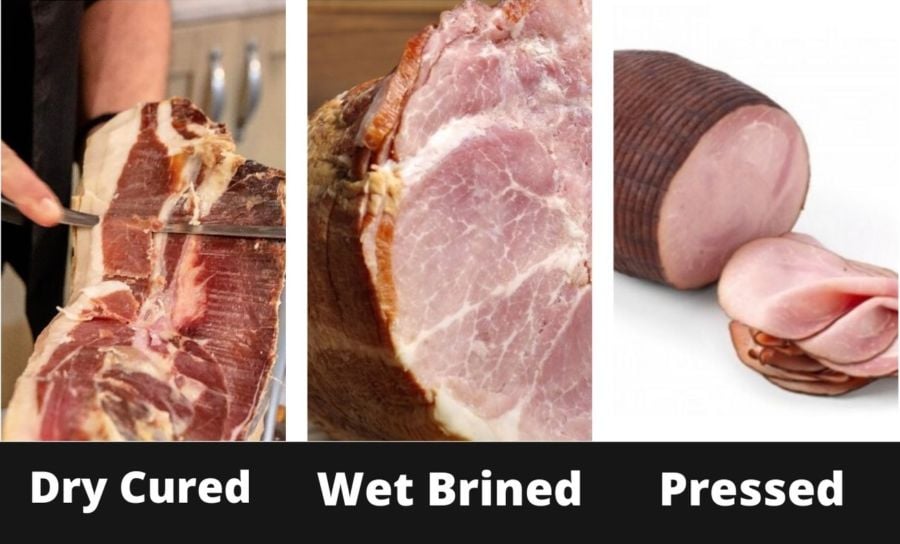
Culatello
Culatello is often called the “king of cured meats” in Italy—and for good reason. It’s made from boneless hind pork leg, cured with salt and wine, and aged for up to 24 months in the foggy cellars of Parma and Zibello. While technically a cousin of prosciutto, its deep flavor and buttery texture make it a high-end substitute that’s even rarer to find outside of the region for the classic variety.
Unlike prosciutto, culatello is always deboned, trimmed to a pear shape, and tied by hand before aging. It’s smaller, dries faster, and is generally more intensely flavored than full-leg prosciutto. If you ever see it on a menu or at a deli—try it. I’ve tasted and cured versions myself, and the depth of aroma is unmistakable.
It’s not cheap, and it’s not everywhere, but culatello is probably the closest thing to prosciutto in terms of heritage, craft, and complexity. Use it in the same way—served at room temperature, wafer-thin, on a board or with fresh bread and fruit.
On to a very different—but equally delicious—European cured ham: Black Forest.
Black Forest Ham
Black Forest Ham (Schwarzwälder Schinken) hails from Germany and is a cold-smoked, dry-cured pork leg that delivers a smoky punch while keeping the same preservation goals as prosciutto. It’s cured with salt and spices, aged until it loses about 40% of its weight, and cold-smoked over fir or spruce for days at a time.
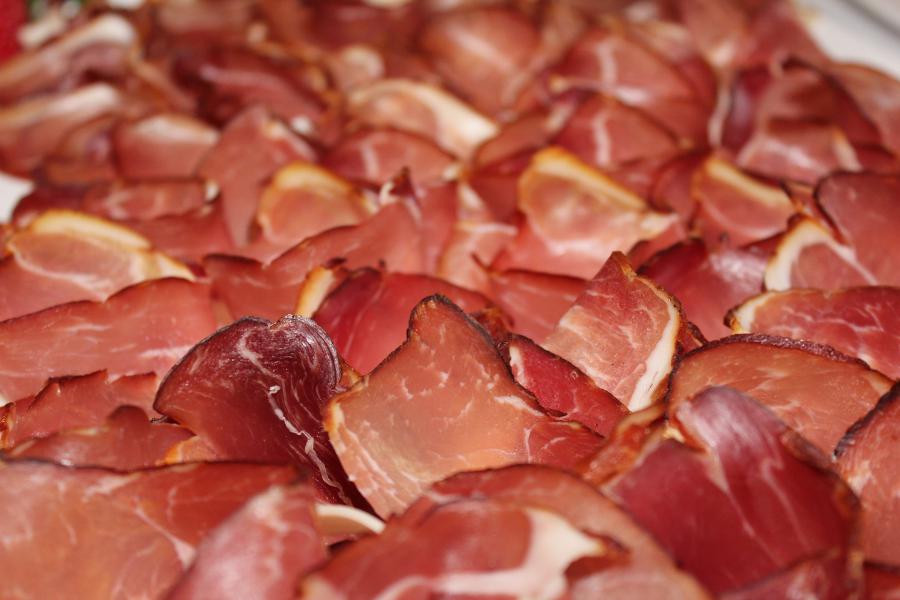
In terms of texture and appearance, it’s quite close to prosciutto—especially when sliced thin. The flavor is noticeably different, though: a mix of salt, smoke, and spice that makes it feel heartier. I’ve had some beautiful versions aged to just the right balance, where the fat picks up a gentle smoke and the lean muscle becomes complex and savory.
As with any dry-cured ham, the fat distribution and weight loss during aging are essential. I explain that more in my guide on what is equilibrium curing and why it matters, which applies to Black Forest ham too.
Do watch out—there are cooked supermarket versions labeled “Black Forest Ham” that are nothing like the traditional type. If you’re after a real prosciutto substitute, you want the raw, dry-cured, cold-smoked kind. It usually has a dark outer bark, firm interior, and a clean, smoky aroma.
Germany even protects the name and method under PGI laws. If you want to dig deeper into the process, check out the Black Forest Ham traditional PGI production guide.
Next, we’ll look at two intensely flavored options: Iberian Jamon from Spain and the rich, fatty cut known as guanciale.
Iberian Jamon
Jamon Iberico is Spain’s answer to prosciutto, but with its own deeply rooted history, regional pride, and one-of-a-kind flavor. It comes from native Iberian pigs—often black-hoofed—and is cured for at least 12 months, though some are aged for 36 months or more. The most prized type, Jamon Iberico de Bellota, comes from acorn-fed pigs raised in free-range oak forests.
The fat in Iberico ham is incredibly marbled, soft, and often described as “melting in the mouth.” What sets it apart is the sweet nuttiness from the acorns, along with the lengthy dry-curing process that concentrates umami and aroma to levels that rival any prosciutto.
I’ve had the pleasure of tasting high-end Iberico ham straight from a leg mounted on a jamonera stand. You slice it in long ribbons on the bias with a flexible knife, and the result is decadent. If you want a direct comparison to prosciutto, Iberico ham is more intense, often more aged, and unmistakably luxurious.
To see how the best of the best is made, take a look at this overview of Jamon Iberico de Bellota explained by Cinco Jotas, one of Spain’s premier producers.
Now let’s switch from the leg to the cheek—another fatty, flavorful substitute that brings a lot to the table: guanciale.
Guanciale
Guanciale is a dry-cured cut from the pig’s jowl or cheek. It’s extremely rich, high in fat, and packed with flavor—considered by many Italians to be the tastiest cut on the animal. This isn’t a prosciutto replica by any means, but it’s often used in similar contexts: thinly sliced for tasting plates or diced into traditional recipes.
Most people know guanciale from its key role in carbonara or amatriciana, where the rendered fat gives those dishes their unmistakable depth. But when dry-cured properly and sliced thin, guanciale can also be served as a cold cut. The flavor is intensely porky, with a subtle sweetness from the fat that cures into a silky, delicate texture.
I’ve made several batches of guanciale myself and always find the drying and trimming process unique—it’s smaller than most salumi cuts, but the fat-to-meat ratio gives it an outrageous level of flavor. If you’re after something a little more indulgent than prosciutto, this is it.
Speck
Speck is a dry-cured, lightly smoked ham from northern Italy—specifically Alto Adige (South Tyrol). While prosciutto is never smoked, speck combines both curing and smoking to develop a distinctive flavor that’s savory, herbaceous, and just a touch smoky. It’s made from pork hind leg like prosciutto, then cured with salt, juniper, and garlic before being cold-smoked and aged for about 6 months.
I’ve found Speck to be a fascinating cross between prosciutto and traditional smoked ham. When sliced wafer-thin, the aroma hits first—smoke, spice, and aged pork all at once. While it’s leaner than pancetta or guanciale, the meat-to-fat balance is still rich enough to melt slowly on your tongue if brought to room temperature before serving.
Speck is especially versatile—it can be laid out on a charcuterie board, wrapped around fruit or cheese, or folded into pasta and egg dishes. Just be mindful that the smoke does add a different element, so it’s not a direct flavor twin of prosciutto. But in terms of texture, slicing style, and aging, it’s very close.
If you’re curious about what makes Speck unique, the PGI (Protected Geographical Indication) certification means it’s made according to very specific regional rules. You can find more about it from the Traditional Speck PGI from Alto Adige website—well worth a look if you want to explore true smoked Italian salumi.
What Is Prosciutto?
Prosciutto is a dry-cured ham made from the hind leg of a pig, aged anywhere from 9 months to over 3 years depending on the region and style. It’s crafted using just pork and salt—no nitrates, sugar, or smoke. This minimal ingredient list is why the breed of pig, its feed, and the drying environment make such a huge difference in the final product.
The traditional process begins with salting the pork leg to draw out moisture and inhibit harmful bacteria. Over weeks and months, the salt migrates deeper into the muscle, setting the stage for slow enzymatic breakdown. The leg is then hung to dry and age in a controlled environment where temperature, airflow, and humidity all influence the final flavor and texture.
This slow aging intensifies flavor and makes prosciutto incredibly shelf-stable. The meat gradually loses water—up to 30–40% of its weight—while the fats soften and develop aroma. All of this happens without cooking, smoking, or artificial preservatives.
The best-known version is Prosciutto di Parma, which is protected by EU PDO certification. It must be made from heritage pigs raised on a strict grain-based diet (often including whey from Parmigiano-Reggiano cheese production), and aged for at least 12 months. For full details on how it’s made, check the Prosciutto di Parma official consortium site.
What Does Prosciutto Taste Like?
Prosciutto’s flavor is delicate yet deeply savory. It has a sweet nuttiness from the fat, a gentle saltiness, and a tender texture that becomes silky when sliced ultra-thin. If you’ve ever had prosciutto freshly cut with a deli slicer, you’ll know that the thinness of the slice plays a huge role in how balanced the salt and flavor come across.
Depending on the region, prosciutto may be slightly sweeter or more herbaceous. Some Italian styles (like San Daniele) are more aromatic, while others focus purely on salt and pork. Generally, if the ingredients list includes more than salt and pork, it’s not a traditional prosciutto.
The color ranges from rosy pink to a deep mahogany, often with bright white marbling or creamy ribbons of fat. And unlike smoked meats, prosciutto’s flavor stays clean, elegant, and full of natural umami developed from long aging—not seasoning.
Now that we’ve covered how prosciutto is made and why it’s so special, let’s quickly summarize the best substitutes and when to use them.
In short, these are my go-to substitutes when prosciutto isn’t available:
- Serrano Ham – Balanced, nutty, and widely available
- Capicola / Coppa – Rich, spicy, and beautifully marbled
- Pancetta – Fatty and versatile when sliced wafer-thin
- Culatello – Refined and rare, with bold flavor
- Black Forest Ham – Smoky, dry-aged, and firm
- Iberian Jamon – Deep, nutty, and intensely flavorful
- Guanciale – Fat-forward with rich porky complexity
- Speck – Gently smoked with Alpine spice aroma
What can I use instead of prosciutto in a recipe?
Great substitutes include Serrano ham, capicola, pancetta (dry-cured and sliced thin), or Black Forest ham. All offer similar textures and salt levels if sliced thinly and served correctly.
Can I use bacon instead of prosciutto?
Bacon is not an ideal substitute for prosciutto because it’s typically smoked and raw. It can work in cooked dishes if crisped, but it doesn’t offer the same delicate texture or aging depth as dry-cured ham.
Is pancetta the same as prosciutto?
No. Pancetta comes from pork belly and is often cured, but not always aged for a long time. It has spices added, which prosciutto traditionally doesn’t. When sliced thinly, it can serve as a substitute in certain applications.
Have a favorite prosciutto alternative I didn’t mention? Drop a comment below—I’d love to hear what cured meats you’re slicing up at home!

Tom Mueller
For decades, immersed in studying, working, learning, and teaching the craft of meat curing, sharing the passion and showcasing the world of charcuterie and smoked meat. Read More
